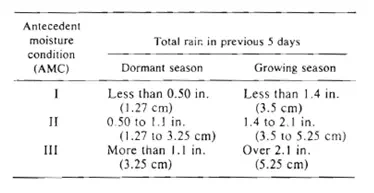Estimation of Runoff-II
SCS Curve Number Method
This method is developed by the Soil Conservation Service (SCS) in 1969. It is now known as Natural Resources Conservation Service (NRCS).
The fundamental hypotheses of the SCS-CN method are as follows:
a) Runoff starts after an initial abstraction Iahas been satisfied. This abstraction consists principally of interception, surface storage, and infiltration.
b) The ratio of actual retention of rainfall to the potential maximum retention S is equal to the ratio of direct runoff to rainfall minus initial abstraction.
Mathematically,

Where is the runoff volume uniformly distributed over the drainage basin, P is the mean precipitation over the drainage basin, and S is the retention of water by the drainage basin. The quantity Iacan be expressed as a function of S. For Indian Conditions,Ia = 0.3S. Physically, this means that for a given storm, 20% of the potential maximum retention is the initial abstraction before runoff begins. Presumably, 0.8S represents other retention losses, including interception, infiltration, evapotranspiration, and depression storage. Therefore,
 (20.2A)
(20.2A)
Or
 (20.2B)
(20.2B)
Evidently this is a one-parameter model containing S as the parameter and is illustrated graphically in Fig. 20.1.

Equation ( ) is a form of the hydrologic budget,
 (20.3a)
(20.3a)
in which L accounts for losses expressed as
 (20.3b)
(20.3b)
In a limiting case, as P → ∞, L → 1.2 S and not S.
Estimation of S
The parameter S depends upon characteristics of the soil-vegetation-land use (SVL) complex and antecedent soil-moisture conditions in a watershed. For each SVL complex, there is a lower limit and an upper limit of S. The Soil Conservation Service expressed S as a function of curve number as
 (20.4)
(20.4)
Or
 (20.5)
(20.5)
Where CN is the curve number; it is a relative measure of retention of water by a given SVL complex and takes on values from 0 to 100. This number is derived from the character of the soil; vegetation, including crops; and the land use of that soil, as well as intensity of use. The unit of S is mm. obviously, when CN equals 100, S becomes zero. This leads to VQ = P. When S , CN 0.
This yields VQ= 0 for all P when S = and CN = 0. Substitution of Eq. (20.5) into Eq. (20.2a) yields
 (20.6)
(20.6)
In this equation, CN is the only parameter to be determined.
Estimation of CN
The CN value is determined from (a) soil type and (b) antecedent moisture conditions. Soils have been classified in four groups. A short description is given here.
a) Group A: Soils in this group have a low-runoff potential (high-infiltration rates) even when thoroughly wetted. They consist of deep, well to excessively well-drained sands or gravels. These soils have a high rate of water transmission.
b) Group B:Soils in this group have moderate infiltration rates when thoroughly wetted and consist chiefly of moderately deep to deep, well-drained to moderately well-drained soils with moderately fine to moderately coarse textures. These soils have a moderate rate of water transmission.
c) Group C: Soils have slow infiltration rates when thoroughly wetted and consist chiefly of soils with a layer that impedes the downward movement of water, or soils with moderately fine to fine texture. These soils have a slow rate of water transmission.
d) Group D:Soils have a high-runoff potential (very slow infiltration rates) when thoroughly wetted. These soils consist chiefly of clay soils with high swelling potential, soils with a permanent high-water table, soils with a clay pan or clay layer near the surface, and shallow soils over nearly impervious material. These soils have a very slow rate of water transmission.
Antecedent Moisture Conditions
Antecedent moisture condition (AMC) refers to the water content present in the soil at a given time. The AMC value is intended to reflect the effect of infiltration on both the volume and rate of runoff, according to the infiltration curve of Fig.20.1. The Soil Conservation Service developed three antecedent soil-moisture conditions and labeled them as I, II, and III. These AMCs correspond to the following soil conditions:
a) AMC I: Soils are dry but not to the wilting point; satisfactory cultivation has taken place.
b) AMC II: Average conditions.
c) AMC III: Heavy rainfall, or light rainfall and low temperatures have occurred within the last 5 days; saturated soil.
Table1 .Provides seasonal rainfall limits for the three antecedent soil-moisture infiltration conditions.
Table 1. Antecedent moisture conditions for determining the value of CN(Source: Singh, 1994)

Selection of CN
The procedure for selecting the actual value of CN for any given application begins in Table 20.2. The value of CN is shown for AMC condition II and for a variety of land uses, soil treatment, or farming practices. The hydrologic condition refers to the state of the vegetation growth. Upon selecting the applicable crop cover, treatment, and hydrologic condition, the value of CN is found under the appropriate soil group for AMC II. The value of CN is lower for soils with high infiltration than for soils with low infiltration.
Table 20.2. Runoff curve numbers for hydrologic soil-cover complex

Table 20.3 provides conversion from AMC II to AMC I and AMC III. After determining the CN value for AMC II, Table 20.3 is entered at this value in column I. Values for AMC I, AMC III, S, and P are found in adjoining columns. These data can then be applied to determine runoff volume VQ.
Table 20.3. Curve numbers (CN) and constants for the case Ia= 0.2S
